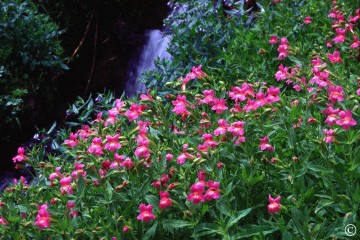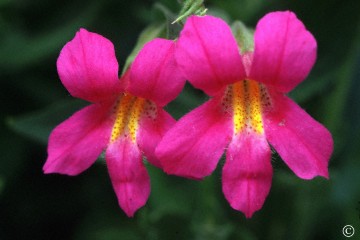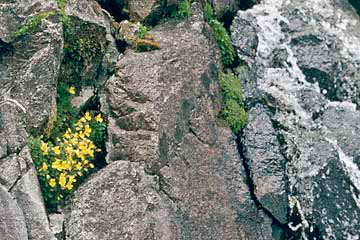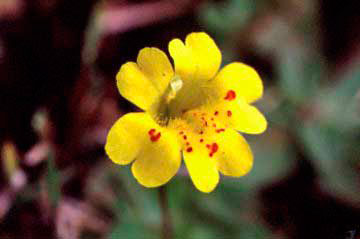
Lewis’s (or Purple) Monkeyflower, Mimulus lewisii Pursh, has large, rose-colored blooms, accentuated by a red-spotted yellow palate on the central petal of the lower lip. It commonly grows along mountain streams, blooming at least as high as tree-line. The species name honors Captain Meriwether Lewis who collected the plant near Lemhi Pass on the border of today's Montana and Idaho, on August 12, 1805; it grows in the same place today. It was named by Frederick Pursh (1774-1820), a German botanist working in Philadelphia. In 1813 Pursh published a flora of North American plants, based in part on the expedition's material.


The common yellow mimulus, Mimulus guttatus DC., (not shown) looks so much like the subalpine plant that the two species are hard to tell apart. It grows near seep springs and other moist places, from sea-level to mid-elevations. A taller, rangier plant. its flowers appear identical to those of the sub-alpine monkey flower, so much so that one would expect them to be variants of the same species. Recent studies, however, show that they are genetically separate. Meriwether Lewis found the yellow mimulus, Mimulus guttatus, on the Blackfoot River during the expedition's return journey, a few miles above present-day Missoula, MT on July 4, 1806.


Musk-flower, Mimulus moschatus Douglas ex Lindl. (right), named for its odor, is a plant of the Northwest (although, interestingly, a disjunct population grows on the northeastern seaboard, north to Labrador). The plants usually grow near streams or in other moist places. Because the flowers are obscurely lipped, and the petals have no red markings, the plants may not be recognized as monkey-flowers when first seen.


Suksdorf's mimulus, Mimulus suksdorfii Gray (right) is a tiny mimulus. Its flowers, greatly magnified here, measure only about 1/8 inch across. It is found in most states west of the Dakotas and Texas. This plant was formerly listed on this site as Mimetanthe pilosa (Benth) Greene--a small mimulus-like plant with much the same distribution. The reddish calyx helps with proper identification. (Photographed at the Craters of the Moon National Monument).
